It’s a special feeling, gliding effortlessly through pristine, untouched snow, carving your way down a mountain as though you’re floating. Powder skiing offers a freedom unlike any other, providing skiers with a unique and exhilarating experience. But it’s not without its challenges. Whether you’re a seasoned piste skier or just getting started, learning to ski powder can feel daunting.
In this guide, we’ll break down some core areas to help master powder skiing. From understanding the differences between powder and piste to fine-tuning your technique and exploring different terrains, if you’re faced with some fresh powder days this season, let’s get you prepared.
What Is Powder Skiing?
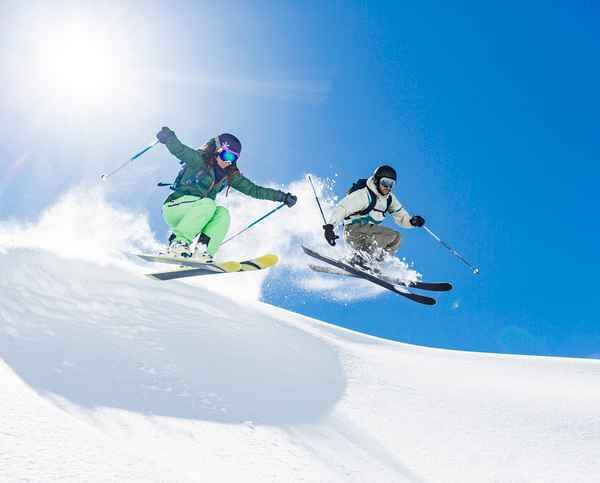
Powder skiing refers to skiing on soft, natural snow that hasn’t been compacted or groomed. Powder snow can vary widely in depth and consistency, from light and fluffy to dense and wet. What makes it so special is the way it transforms the experience. Skiing on powder feels like gliding or floating, offering a thrilling sense of freedom.
For many, powder skiing is the pinnacle of the sport, but it requires a different approach from the firm, predictable surfaces of groomed pistes.
Powder Skiing vs. Piste Skiing – What’s the difference?
Skiing on powder is a whole different game compared to skiing on groomed slopes. Here are the key distinctions:
Terrain: Powder skiing typically takes place off-piste, in unmarked and ungroomed areas. This means the terrain can be unpredictable, with natural obstacles like trees and rocks.
Snow Consistency: Powder is much softer and deeper than the hard-packed snow of a piste. This can make it more challenging to maintain balance and control.
Technique: On piste, carving turns involves gripping the snow. In powder, you’ll need to adapt to a lighter, more fluid style of movement to stay afloat.
Is it more difficult to ski in powder?
Yes, skiing in powder is more challenging, especially for beginners. The softness of the snow means your skis won’t have the same grip or resistance as they do on a groomed run. Balancing, turning, and maintaining momentum all require practice and patience.
However, the rewards are worth the effort. Once you master the basics, powder skiing feels effortless and exhilarating, opening up a world of possibilities for exploring the mountain.
Powder skiing for beginners
If you’re new to powder skiing, don’t worry—it’s a skill you can build with time and practice. Here are a few tips for beginners:
o Start Small: Begin with shallow powder on gentle slopes to get a feel for the snow.
o Stay Relaxed: Tension in your body can throw off your balance. Keep your movements fluid and natural.
o Practice Drills: Work on short, rhythmic turns and maintaining speed to build confidence.
Powder skiing technique
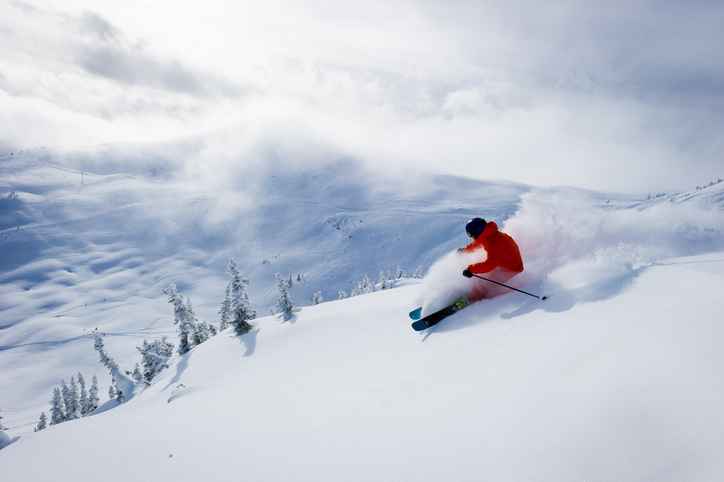
To ski powder successfully, you’ll need to adjust your technique. Here’s what to focus on:
Stance
Keep your stance slightly wider than hip-width for better stability. Stay balanced over the centre of your skis.
Rhythm
Powder skiing is all about smooth, rhythmic turns. Avoid abrupt movements, and let your skis flow naturally.
Momentum
Speed is your friend in powder. Maintaining a bit of momentum helps you stay on top of the snow rather than sinking, especially on flatter terrain.
Weight Distribution
Don’t lean too far back. Instead, keep your weight centred and let your skis do the work.
For more of a visual take a look at this video from Stomp it Tutorials on How to Ski Powder.
Common mistakes when skiing powder
Even experienced skiers can make mistakes in powder. Here are a few to watch out for:
Over-Turning
Avoid aggressive movements. Powder skiing is about subtlety and flow. Plus, excessive turning can quickly tire you out.
Using Piste Techniques
Don’t rely on the same carving style you use on groomed slopes. Powder requires a lighter touch.
Ignoring Terrain
Pay attention to natural changes in the snow and the lay of the land. For example, you will need greater momentum for flatter terrain and if you need to get up a hill.
Should you lean back when skiing powder?
One of the biggest misconceptions in powder skiing is that you need to lean back. While it’s true that you don’t want to be too far forward, leaning back excessively will make it harder to control your skis and increase fatigue.
The key is to maintain a centred, balanced posture. Your weight should be evenly distributed, with just a slight adjustment to keep your tips above the snow.
Powder skiing in different terrain
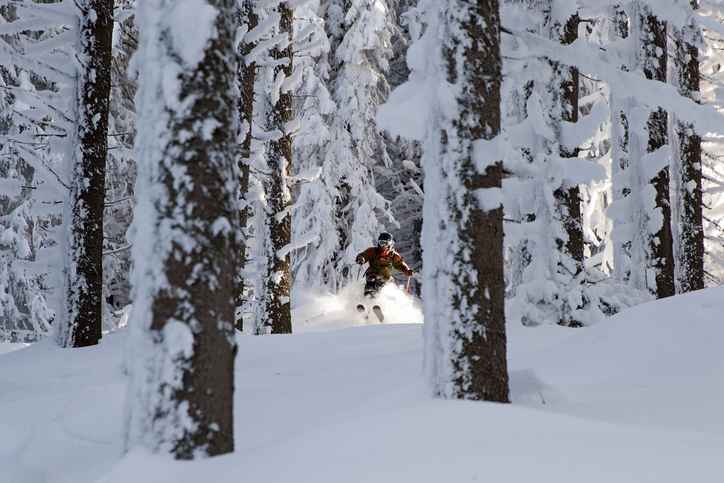
Powder skiing becomes even more thrilling when you take on various types of terrain. Each environment offers its own challenges and rewards, requiring you to adjust your technique and approach. Here’s an in-depth look at how to tackle different terrains while enjoying the unique experience powder provides.
Open Bowls
Why Ski Open Bowls?
Open bowls are often the go-to choice for powder skiing. Their wide, expansive nature provides plenty of room to experiment with big, sweeping turns, making them ideal for building confidence in deep snow.
Techniques to Master:
o Use the space to your advantage by focusing on smooth, flowing turns.
o Keep a consistent rhythm to maintain momentum and avoid sinking.
o Stay aware of subtle changes in the snow, as wind or sun can create pockets of denser or crusty snow.
Ski Tip:
Open bowls often feel forgiving but watch out for hidden dips or convex rolls that can catch you off guard.
Tree Skiing
Why Ski in Trees?
Tree skiing offers an adrenaline rush as you navigate tight spaces, requiring quick reflexes and precise movements. It’s also a haven for finding untouched powder, as trees often protect snow from wind and sun exposure.
Techniques to Master
o Keep your stance slightly narrower than usual for better manoeuvrability.
o Look ahead to plan your route—don’t focus on the trees themselves!
o Use short, controlled turns to navigate gaps while maintaining speed.
Ski Tip:
If you feel yourself losing control, aim for an open patch to regain composure. Also, always wear a helmet and avoid skiing too close to the trunks.
Steep Terrain
Why Ski Steeps?
Steep terrain adds an extra layer of challenge and excitement to powder skiing. The incline helps maintain speed and prevents sinking into the snow, but it also demands more precise control.
Techniques to Master:
o Use short, controlled turns to manage your descent and keep your speed in check.
o Stay light on your feet and keep your upper body stable to avoid over-rotating.
o Engage your edges gently, allowing the powder to cushion your turns.
Ski Tip:
Always scout the slope before descending. Look for safe entry points and assess the snow stability, as steeper slopes are more prone to avalanches.
Rolling Terrain
Why Ski Rolling Terrain?
Rolling terrain provides a playful and dynamic experience, with its natural dips and rises adding variety to your run. It’s excellent for practising balance and adapting to changing conditions.
Techniques to Master:
o Use your knees and legs as shock absorbers, flexing and extending to smoothly handle the contours.
o Keep your weight centred to prevent tipping forward or back on uneven ground.
o Adjust your speed to maintain control through the ups and downs.
Ski Tip:
Be cautious in low-visibility conditions, as rolling terrain can hide unexpected drops or obstacles.
Flat Sections
Why Ski Flats?
While not the most exciting part of a run, flat sections are often unavoidable, especially when transitioning between slopes or navigating lower sections of powder fields. Staying prepared can prevent frustrating stops.
Techniques to Master:
o Maintain your momentum—carrying speed into flat sections is essential to avoid getting stuck.
o Stay centred on your skis and avoid leaning back, which can reduce your control.
o Use subtle, gentle pushes with your poles if you start to slow down.
Ski Tip:
If you know a flat section is coming, pick up speed beforehand and keep your turns minimal to conserve energy.
Mixed Terrain
Why Ski Mixed Terrain?
Runs that combine trees, steeps, and rolling sections offer variety and challenge, pushing your skills to adapt on the fly. Mixed terrain is also where the mountain’s natural beauty truly shines.
Techniques to Master:
o Be ready to shift your weight and adjust your rhythm as conditions change.
o Stay focused on the terrain ahead, anticipating obstacles and transitions.
o Pace yourself—mixed terrain can be physically demanding, so take breaks as needed.
Ski Tip:
Scout the run beforehand if possible. Knowing what’s ahead will help you plan your approach and avoid surprises.
Equipment for powder skiing
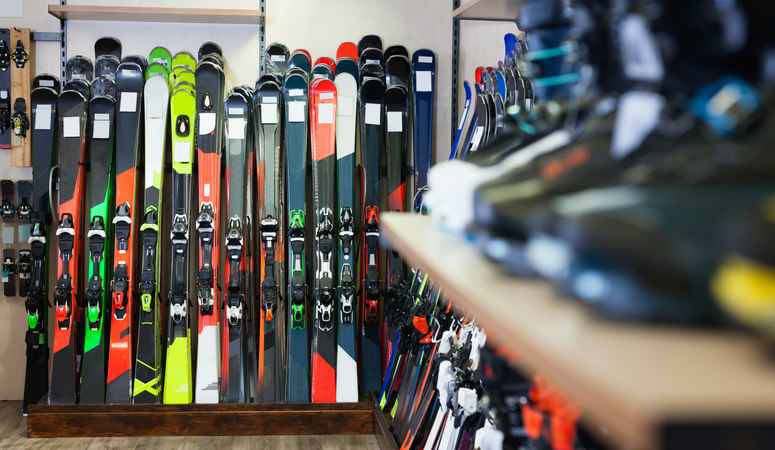
Having the right gear makes a big difference in powder skiing. If you’re skiing powder off-piste, you’ll want to take avalanche equipment, just in case. You’ll also want to think about the sort of skis you use.
What are powder skis?
Powder skis are designed specifically to help you glide effortlessly through soft, deep snow. Their wider shape and rocker design enable better floatation, keeping you on top of the powder rather than sinking into it. Unlike piste skis, they often have greater flexibility, allowing you to navigate softer snow with ease rather than focusing on carving on harder, groomed surfaces.
For most skiers, an all-mountain ski is the go-to choice, offering versatility to adapt to various conditions. Dedicated powder skis are typically favoured by experienced or regular skiers who spend a lot of time exploring specific snow terrains and want equipment tailored for maximum performance.
Avalanche Equipment
If you’re skiing off-piste, safety is crucial. Always carry a transceiver, probe, and shovel, and ensure you’re trained in avalanche awareness.
Additional tips for mastering powder skiing
Practice Makes Perfect: Spend time honing your technique on powder-friendly days.
Choose the Right Day: Ideal powder conditions make learning much easier.
Ski with Friends: Having experienced skiers with you can be both helpful and safer.
Stay Relaxed: Remember, skiing is supposed to be fun. Don’t overthink it!
Safety when powder skiing
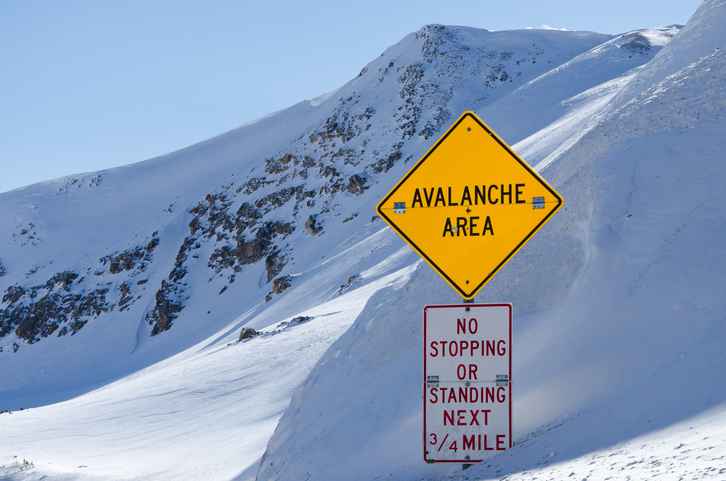
Skiing in powder is exhilarating, but it also comes with increased risks, especially when venturing off-piste. Ensuring your safety and the safety of those around you should always be a top priority. Here are some essential safety tips to keep in mind:
Understand avalanche risks
Learn About Avalanche Terrain
Familiarise yourself with the signs of potential avalanches, such as recent snowfall, wind-loaded slopes, and steep terrain.
Check Avalanche Reports
Before heading out, always check the local avalanche forecast and avoid areas with high risk.
Stick to Safer Slopes
If you’re new to off-piste skiing, start with gentler terrain and avoid slopes above 30 degrees, which are more prone to avalanches.
Carry essential safety equipment
If you’re skiing off-piste, always carry the following avalanche safety gear:
Transceiver: Helps rescuers locate you if you’re buried under snow.
Probe: Used to pinpoint the location of a buried skier.
Shovel: Essential for digging out someone who’s been buried. Ensure you know how to use these tools effectively—practice is crucial.
Ski with a partner or group
Never ski powder alone. A partner or group can assist in an emergency and help watch for hazards. Agree on a plan and stick together, keeping visual contact whenever possible.
Be prepared for changing conditions
Weather Awareness: Powder conditions can change rapidly with shifts in weather. Fog, wind, or fresh snowfall can reduce visibility and increase risks.
Navigation Skills: Carry a map, compass, or GPS device, especially in unfamiliar terrain. It’s easy to lose your bearings in deep snow or poor visibility.
Manage fatigue
Skiing powder is physically demanding. Take regular breaks to avoid exhaustion, as tiredness can lead to mistakes and increase the risk of accidents.
Respect the mountain
Avoid Closed Areas: These are often marked for a reason, such as unstable snow or hidden hazards.
Watch for Hidden Obstacles: Rocks, tree stumps, or sudden drops can be concealed under deep snow. Stay alert and choose your line carefully.
Get educated
Consider taking an avalanche safety course to build your knowledge and confidence when skiing off-piste.
Learn basic first aid skills so you can respond effectively in an emergency.
Trust your instincts
If something doesn’t feel right—whether it’s the snow conditions, weather, or terrain—trust your gut and play it safe. There’s always another powder day.
Get Off-Piste Skiing Insurance from SportsCover Direct
Typically, you will be enjoying your powder skiing off-piste so having the appropriate level of insurance is crucial to cover scenarios whereby you need search and rescue or sustain an injury requiring medical attention. Not all policies cover off-piste skiing so it’s important to know you have the right level of cover for your activities.
SportsCover Direct’s off-piste skiing insurance offers various levels of cover to suit your needs. Our travel insurance includes emergency medical cover, trip cancellation, search and rescue, sports equipment and much more. Alternatively, you can select our bolt-on if you already have an insurance policy but need the specialist off-piste cover.
Find out more and get a personalised quote today. If you need any help, our team are just a phone call or email away.
This blog has been created as general information and should not be taken as advice. Make sure you have the correct level of insurance for your requirements and always review policy documentation.